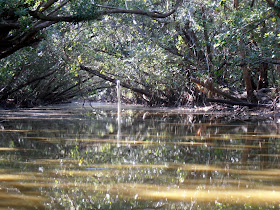A gravel road parallels the Buttonwood Canal north from the Flamingo Visitor Center. During our early February, 2013, trip to Everglades National Park, we explored the road and found very few locations to get good views of the canal until we came to the end of the road. Here, a short trail to the right leads to the Buttonwood Canal while a slightly longer trail to the left leads to the Bear Lake Canal. The trail between the two canals is also a portage of about 250 yards. The Bear Lake Canal has a small dock that can be used to launch canoes or kayaks. A 1.6 mile walking trail follows the Bear Lake Canal canoe trail to Bear Lake. Even in the winter dry season, there were too many mosquitoes for us to attempt the hike.
 |
| Bear Lake Canal dock |
 |
| Bear Lake Canal |
 |
| Looking across Buttonwood Canal |
 |
| Looking north up the Buttonwood Canal |
The park entrance fee is $10 per vehicle for seven consecutive days.
The park website is http://www.nps.gov/ever/index.htm.





















































